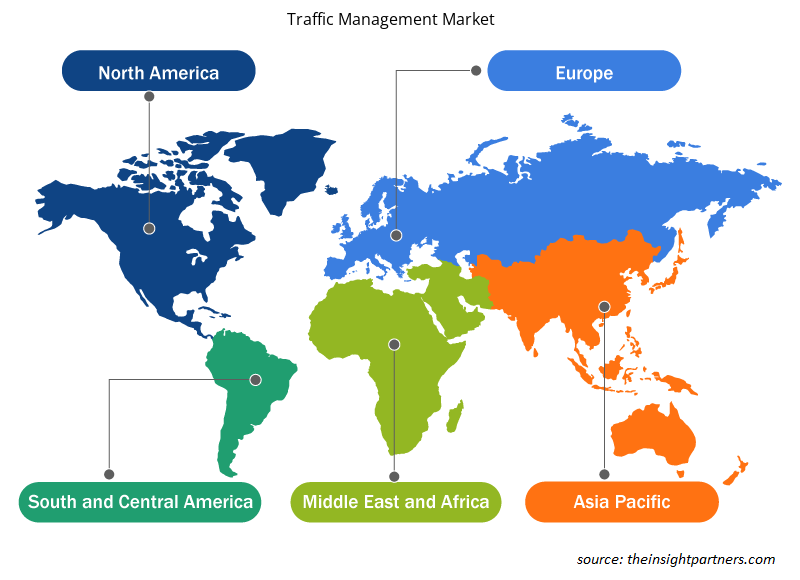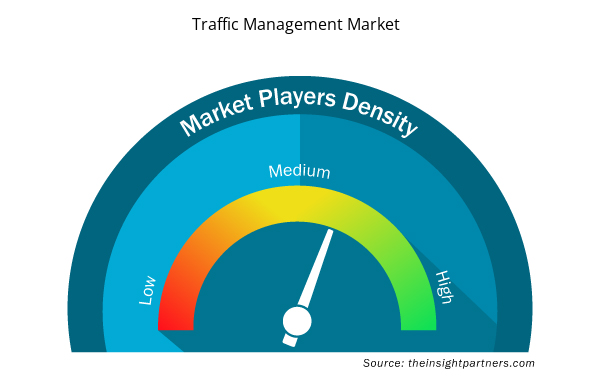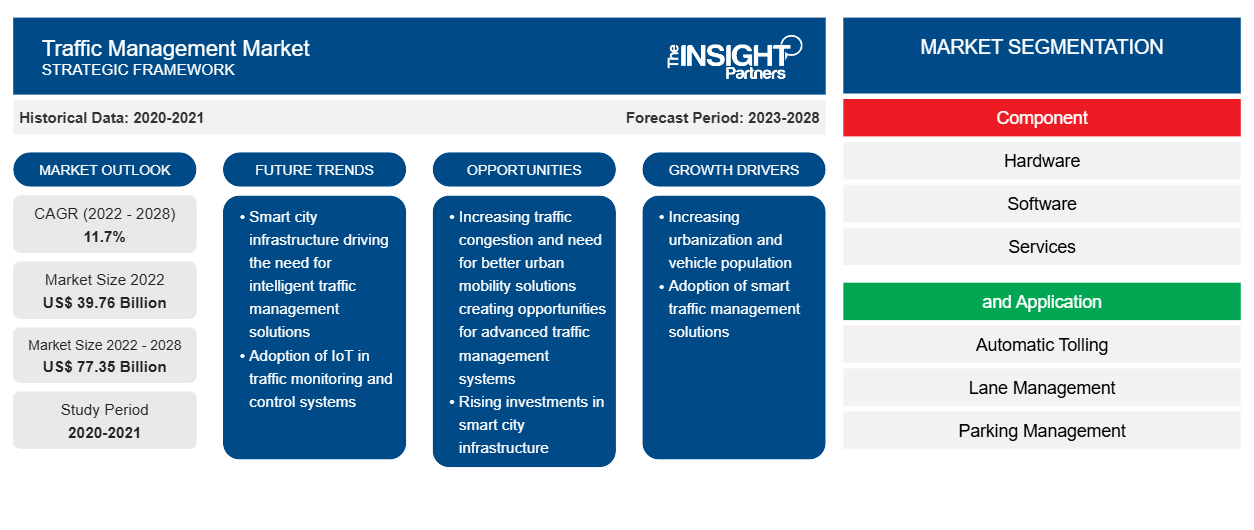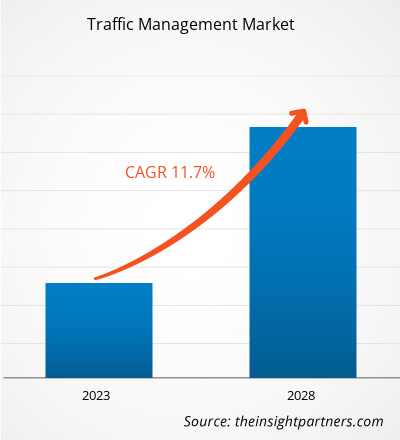Se proyecta que el mercado de gestión de tráfico alcance los US$ 77.346,44 millones en 2028 desde los US$ 39.756,74 millones en 2022; se espera que crezca a una CAGR del 11,7% entre 2022 y 2028.
La mayoría de los países han sido testigos de una drástica urbanización a lo largo de los años, lo que ha dado lugar a redes viales complejas y una alta congestión. El aumento de la población urbana, junto con el aumento de la propiedad de vehículos privados, aumenta el número de vehículos en la carretera. La población de Mumbai, India, aumentó de 18,5 millones en 2011 a 20,4 millones en 2020, mientras que el número de vehículos privados casi se duplicó durante este período. Debido a estos factores, y para remediarlos, se estima que el mercado de gestión del tráfico crecerá. Además, los servicios de transporte de agregadores de taxis, como Uber, Grab, Ola y Lyft, han aumentado a un ritmo rápido. Estos servicios han estado sustituyendo a los sistemas de transporte público, lo que ha provocado un aumento de los vehículos en la carretera. Estos factores están obligando a las autoridades gubernamentales a acercarse a los actores del mercado de gestión del tráfico para obtener soluciones efectivas. La congestión del tráfico se puede reducir de manera efectiva con un sistema de gestión del tráfico sólido, que comprenda software, sensores, cámaras y paneles de visualización. Estos sistemas se pueden instalar en una carretera existente sin los requisitos de modificación de la infraestructura. De manera similar, un sistema de gestión de carriles puede gestionar eficazmente el flujo de tráfico abriendo o cerrando carriles, dependiendo de la velocidad del tráfico en cada momento. Considerando las ventajas que ofrecen los sistemas de gestión de tráfico, se espera que la rápida tasa de urbanización impulse fuertemente el tamaño del mercado de gestión de tráfico.
Impacto de la pandemia de COVID-19 en el crecimiento del mercado de gestión del tráfico
El brote de COVID-19 afectó a sectores industriales como el automotriz, la manufactura, la energía y la electricidad, la industria aeroespacial y de defensa y la construcción en 2020. El continuo crecimiento en el número de pacientes con COVID obligó a las autoridades gubernamentales de los EE. UU. y otros países a imponer estrictos confinamientos en los primeros tres trimestres de 2020. Esto provocó una disminución significativa del transporte en todos los países. La implementación de medidas de contención, como prohibiciones comerciales, restricciones de viaje y limitaciones de la fuerza laboral, afectó las actividades de fabricación, suministro y ventas de varias empresas, incluidas las empresas que brindan hardware, software y servicios de gestión del tráfico. El sector manufacturero fue testigo de graves pérdidas debido a cierres temporales de fábricas y bajos volúmenes de producción, lo que también obstaculizó la producción de sistemas de hardware de gestión del tráfico. En los EE. UU., el gobierno federal y estatal se centró más en abordar la pandemia; como resultado, la instalación de hardware y software de gestión del tráfico se suspendió temporalmente. La industria europea de gestión del tráfico se vio gravemente afectada debido a una disminución de aproximadamente el 20 % en el gasto en proyectos de infraestructura, lo que resultó en retrasos y la interrupción de varios proyectos de ciudades inteligentes y carreteras inteligentes. El aumento de los precios de los semiconductores y las interrupciones en las cadenas de suministro agravaron aún más la situación. Sin embargo, el mercado de gestión del tráfico comenzó a experimentar un crecimiento positivo en el cuarto trimestre de 2020.
Personalice este informe según sus necesidades
Obtendrá personalización en cualquier informe, sin cargo, incluidas partes de este informe o análisis a nivel de país, paquete de datos de Excel, así como también grandes ofertas y descuentos para empresas emergentes y universidades.
- Obtenga las principales tendencias clave del mercado de este informe.Esta muestra GRATUITA incluirá análisis de datos, desde tendencias del mercado hasta estimaciones y pronósticos.
Perspectivas de mercado: mercado de gestión del tráfico
El mundo está siendo testigo de un auge en los dispositivos conectados y varios países están invirtiendo en el desarrollo de ciudades inteligentes. Las ciudades inteligentes son áreas urbanas tecnológicamente avanzadas que emplean una variedad de sensores y métodos electrónicos para recopilar datos y utilizarlos para la mejora de la localidad. Las ciudades inteligentes están diseñadas con planes a largo plazo para gestionar el tráfico mediante la optimización del transporte y la logística y la reducción de la congestión. Por lo tanto, junto con las ciudades inteligentes, los países también están invirtiendo en el desarrollo de carreteras inteligentes para proporcionar un viaje en vehículo más seguro. En las carreteras inteligentes, diferentes tipos de sensores y hardware recopilan datos multivariados que se utilizan para monitorear el tráfico. Los datos también se pueden compartir con los vehículos que viajan en la carretera, lo que permite a los conductores y pasajeros tomar decisiones informadas. Por lo tanto, se puede esperar que la creciente adopción de ciudades inteligentes y carreteras inteligentes impulse el tamaño del mercado de gestión del tráfico.
Información basada en componentes
El mercado de gestión del tráfico está segmentado en función de los componentes, las aplicaciones y la geografía. El mercado, por componente, se segmenta en hardware, software y servicios. El mercado de hardware se segmenta a su vez en cámaras, paneles de visualización y sensores; además, el mercado de software se bifurca en la nube y en las instalaciones. Diferentes agencias gubernamentales han estado invirtiendo en la actualización de su hardware de gestión del tráfico. La creciente urbanización y el aumento de la propiedad de automóviles han estado sobrecargando las carreteras urbanas. Por lo tanto, las autoridades confían en las cámaras modernas para un mejor mantenimiento del flujo de tráfico y garantizar la seguridad. Las cámaras de reconocimiento automático de matrículas (ANPR) se están implementando cada vez más para identificar a los infractores o para localizar vehículos durante las investigaciones de incidentes. A menudo se combinan con sensores láser para determinar la velocidad de un vehículo.
Por aplicación, el mercado de gestión del tráfico se segmenta en peajes automáticos, gestión de carriles, gestión de aparcamientos , vigilancia, gestión de señales de tráfico y otros. Según la geografía, el mercado se segmenta principalmente en América del Norte, Europa, Asia Pacífico (APAC), Oriente Medio y África (MEA) y América del Sur (SAM). IBM Corporation; Cisco Systems, Inc.; Siemens AG; Hangzhou Hikvision Digital Technology Co., Ltd.; y Dahua Technology Co., Ltd. se encuentran entre los actores clave del mercado de gestión del tráfico.
Perspectivas regionales del mercado de gestión del tráfico
Los analistas de Insight Partners explicaron en detalle las tendencias y los factores regionales que influyen en el mercado de gestión del tráfico durante el período de pronóstico. Esta sección también analiza los segmentos y la geografía del mercado de gestión del tráfico en América del Norte, Europa, Asia Pacífico, Oriente Medio y África, y América del Sur y Central.

- Obtenga datos regionales específicos para el mercado de gestión del tráfico
Alcance del informe de mercado de gestión del tráfico
| Atributo del informe | Detalles |
|---|---|
| Tamaño del mercado en 2022 | US$ 39,76 mil millones |
| Tamaño del mercado en 2028 | US$ 77.35 mil millones |
| CAGR global (2022-2028) | 11,7% |
| Datos históricos | 2020-2021 |
| Período de pronóstico | 2023-2028 |
| Segmentos cubiertos | Por componente
|
| Regiones y países cubiertos | América del norte
|
| Líderes del mercado y perfiles de empresas clave |
|
Densidad de actores del mercado de gestión del tráfico: comprensión de su impacto en la dinámica empresarial
El mercado de gestión del tráfico está creciendo rápidamente, impulsado por la creciente demanda de los usuarios finales debido a factores como la evolución de las preferencias de los consumidores, los avances tecnológicos y una mayor conciencia de los beneficios del producto. A medida que aumenta la demanda, las empresas amplían sus ofertas, innovan para satisfacer las necesidades de los consumidores y aprovechan las tendencias emergentes, lo que impulsa aún más el crecimiento del mercado.
La densidad de actores del mercado se refiere a la distribución de las empresas o firmas que operan dentro de un mercado o industria en particular. Indica cuántos competidores (actores del mercado) están presentes en un espacio de mercado determinado en relación con su tamaño o valor total de mercado.
Las principales empresas que operan en el mercado de gestión de tráfico son:
- Comunicaciones Axis AB
- Sistemas Cisco, Inc.
- Corporación cúbica
- Tecnología Dahua Co., Ltd.
- Tecnología digital Co., Ltd. de Hangzhou Hikvision.
Descargo de responsabilidad : Las empresas enumeradas anteriormente no están clasificadas en ningún orden particular.

- Obtenga una descripción general de los principales actores clave del mercado de gestión del tráfico
Los actores del mercado de gestión del tráfico se centran principalmente en el desarrollo de productos avanzados y eficientes.
- En 2021, Dahua Technology anunció el desarrollo de una solución integral de gestión de tráfico inteligente que se desarrolló combinando videovigilancia con IA, ANPR, fusión de imágenes, AR y otras tecnologías de vanguardia para satisfacer las diversas necesidades de los departamentos de control de tráfico modernos.
- En 2021, Hikvision, un proveedor de soluciones de IoT especializado en cámaras, presentó la cámara ITS All-Rounder, su producto de tráfico más nuevo destinado a mejorar la seguridad vial y el flujo de tráfico. La cámara combina una variedad de talentos y capacidades, incluida la detección de velocidad, detección de infracciones de tránsito, identificación automática de matrículas y análisis de atributos del vehículo, todo en un solo paquete.
- Análisis histórico (2 años), año base, pronóstico (7 años) con CAGR
- Análisis PEST y FODA
- Tamaño del mercado Valor/volumen: global, regional, nacional
- Industria y panorama competitivo
- Conjunto de datos de Excel


- Rugged Servers Market
- Explosion-Proof Equipment Market
- Sterilization Services Market
- Biopharmaceutical Contract Manufacturing Market
- Data Center Cooling Market
- Hair Wig Market
- Genetic Testing Services Market
- Photo Printing Market
- Batter and Breader Premixes Market
- Lyophilization Services for Biopharmaceuticals Market

Report Coverage
Revenue forecast, Company Analysis, Industry landscape, Growth factors, and Trends

Segment Covered
This text is related
to segments covered.

Regional Scope
North America, Europe, Asia Pacific, Middle East & Africa, South & Central America

Country Scope
This text is related
to country scope.
Preguntas frecuentes
The traffic management market is expected to reach US$ 77,346.44 million by 2028.
The hardware segment led the traffic management market with a significant share in 2021. It is further expected to dominate the market share over the forecast period. However, software segment is expected to be the fastest growing.
India, China and Italy are expected to register high growth rates during the forecast period.
The US held the largest market share in 2021, followed by Germany.
Asia Pacific is the fastest growing regional market, followed by Europe.
The key players, holding majority shares, in traffic management market includes IBM Corporation; Cisco Systems, Inc.; Siemens AG; Hangzhou Hikvision Digital Technology Co., Ltd.; and Dahua Technology Co., Ltd.
Artificial Intelligence (AI) and Machine Learning (ML) are expected to play a crucial role in the future of the traffic management market. The application of AI and ML in traffic management is still quite nascent, and most countries are yet to adopt the same. However that scenario is changing fast, primarily due to the increasing number of connected cars.
Traffic management market is being driven by the rising urbanization, increasing congestion and growing investment in infrastructure development. Traffic management systems can be installed on an existing road without the requirements of infrastructural modification and thus can greatly aid in reducing congestion.
The global traffic management market was estimated to be USD 39,756.74 Million in 2021, and is expected to grow at a CAGR of 11.7%, during the forecast period 2022 - 2028.
The incremental growth, expected to be recorded for the traffic management market during the forecast period, is US$ 37,589.70 million.
Trends and growth analysis reports related to Technology, Media and Telecommunications : READ MORE..
The List of Companies - Traffic Management Market
- Axis Communications AB
- Cisco Systems, Inc.
- Cubic Corporation
- Dahua Technology Co., Ltd.
- Hangzhou Hikvision Digital Technology Co., Ltd.
- IBM Corporation
- SGS SA
- Siemens AG
- SNC-Lavalin Group
- Teledyne FLIR LLC
The Insight Partners performs research in 4 major stages: Data Collection & Secondary Research, Primary Research, Data Analysis and Data Triangulation & Final Review.
- Data Collection and Secondary Research:
As a market research and consulting firm operating from a decade, we have published and advised several client across the globe. First step for any study will start with an assessment of currently available data and insights from existing reports. Further, historical and current market information is collected from Investor Presentations, Annual Reports, SEC Filings, etc., and other information related to company’s performance and market positioning are gathered from Paid Databases (Factiva, Hoovers, and Reuters) and various other publications available in public domain.
Several associations trade associates, technical forums, institutes, societies and organization are accessed to gain technical as well as market related insights through their publications such as research papers, blogs and press releases related to the studies are referred to get cues about the market. Further, white papers, journals, magazines, and other news articles published in last 3 years are scrutinized and analyzed to understand the current market trends.
- Primary Research:
The primarily interview analysis comprise of data obtained from industry participants interview and answers to survey questions gathered by in-house primary team.
For primary research, interviews are conducted with industry experts/CEOs/Marketing Managers/VPs/Subject Matter Experts from both demand and supply side to get a 360-degree view of the market. The primary team conducts several interviews based on the complexity of the markets to understand the various market trends and dynamics which makes research more credible and precise.
A typical research interview fulfils the following functions:
- Provides first-hand information on the market size, market trends, growth trends, competitive landscape, and outlook
- Validates and strengthens in-house secondary research findings
- Develops the analysis team’s expertise and market understanding
Primary research involves email interactions and telephone interviews for each market, category, segment, and sub-segment across geographies. The participants who typically take part in such a process include, but are not limited to:
- Industry participants: VPs, business development managers, market intelligence managers and national sales managers
- Outside experts: Valuation experts, research analysts and key opinion leaders specializing in the electronics and semiconductor industry.
Below is the breakup of our primary respondents by company, designation, and region:

Once we receive the confirmation from primary research sources or primary respondents, we finalize the base year market estimation and forecast the data as per the macroeconomic and microeconomic factors assessed during data collection.
- Data Analysis:
Once data is validated through both secondary as well as primary respondents, we finalize the market estimations by hypothesis formulation and factor analysis at regional and country level.
- Macro-Economic Factor Analysis:
We analyse macroeconomic indicators such the gross domestic product (GDP), increase in the demand for goods and services across industries, technological advancement, regional economic growth, governmental policies, the influence of COVID-19, PEST analysis, and other aspects. This analysis aids in setting benchmarks for various nations/regions and approximating market splits. Additionally, the general trend of the aforementioned components aid in determining the market's development possibilities.
- Country Level Data:
Various factors that are especially aligned to the country are taken into account to determine the market size for a certain area and country, including the presence of vendors, such as headquarters and offices, the country's GDP, demand patterns, and industry growth. To comprehend the market dynamics for the nation, a number of growth variables, inhibitors, application areas, and current market trends are researched. The aforementioned elements aid in determining the country's overall market's growth potential.
- Company Profile:
The “Table of Contents” is formulated by listing and analyzing more than 25 - 30 companies operating in the market ecosystem across geographies. However, we profile only 10 companies as a standard practice in our syndicate reports. These 10 companies comprise leading, emerging, and regional players. Nonetheless, our analysis is not restricted to the 10 listed companies, we also analyze other companies present in the market to develop a holistic view and understand the prevailing trends. The “Company Profiles” section in the report covers key facts, business description, products & services, financial information, SWOT analysis, and key developments. The financial information presented is extracted from the annual reports and official documents of the publicly listed companies. Upon collecting the information for the sections of respective companies, we verify them via various primary sources and then compile the data in respective company profiles. The company level information helps us in deriving the base number as well as in forecasting the market size.
- Developing Base Number:
Aggregation of sales statistics (2020-2022) and macro-economic factor, and other secondary and primary research insights are utilized to arrive at base number and related market shares for 2022. The data gaps are identified in this step and relevant market data is analyzed, collected from paid primary interviews or databases. On finalizing the base year market size, forecasts are developed on the basis of macro-economic, industry and market growth factors and company level analysis.
- Data Triangulation and Final Review:
The market findings and base year market size calculations are validated from supply as well as demand side. Demand side validations are based on macro-economic factor analysis and benchmarks for respective regions and countries. In case of supply side validations, revenues of major companies are estimated (in case not available) based on industry benchmark, approximate number of employees, product portfolio, and primary interviews revenues are gathered. Further revenue from target product/service segment is assessed to avoid overshooting of market statistics. In case of heavy deviations between supply and demand side values, all thes steps are repeated to achieve synchronization.
We follow an iterative model, wherein we share our research findings with Subject Matter Experts (SME’s) and Key Opinion Leaders (KOLs) until consensus view of the market is not formulated – this model negates any drastic deviation in the opinions of experts. Only validated and universally acceptable research findings are quoted in our reports.
We have important check points that we use to validate our research findings – which we call – data triangulation, where we validate the information, we generate from secondary sources with primary interviews and then we re-validate with our internal data bases and Subject matter experts. This comprehensive model enables us to deliver high quality, reliable data in shortest possible time.


 Obtenga una muestra gratuita de este informe
Obtenga una muestra gratuita de este informe